There was nothing exciting about David Beckham's hair.
After England's 1-0 victory in its World Cup opener against Paraguay on June 10, won by a free kick mistakenly deflected into the goal by the opposing captain, the team was exhausted. A bigger disappointment, for aesthetically minded soccer fans, was that Beckham's tresses -- normally the beau ideal of the soccer world's array of aggressively directional haircuts -- were just tired. His previous dos have included a frosted fauxhawk, blond cornrows and a confection of rooster's peaks, but on June 10 Beckham's hair was, like his game, neatly prostrate and minimally styled. Mere gel, in soccer, is a letdown.
"The British players are tidied up now," said Howard McLaren, the creative director of the Bumble & Bumble salon in New York. Was there a tinge of disappointment in his voice at the recollection of what Beckham's fauxhawk did for men's grooming during the last World Cup in 2002, when the look was widely imitated?
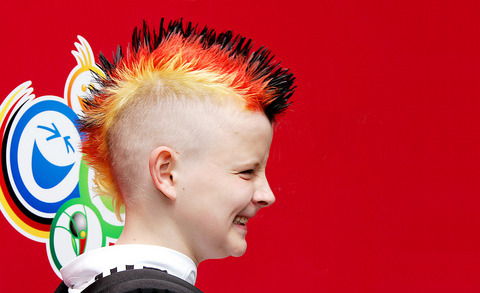
"If you look at the long hair of players from Argentina and Brazil, they are constantly pulling it out of their mouths, which can be distracting," McLaren added. "But they are willing to pay that price for the way their hair looks."
When you are viewed from overhead on a television set for hours on end, hairstyle is substance.
American sports fans are largely unaccustomed to the personal style that is routinely on display at the World Cup. But from now until the final game on July 9, the soccer peacocks will be difficult to ignore. Viewers will see glimpses of Angola's defender, Loco, who wears only a beanstalk patch of braids sprouting from his forehead; Christian Wilhelmsson, a midfielder from Sweden, who has unruly blond spikes and a retro rat's tail; Danijel Ljuboja, a forward from Serbia-Montenegro whose dye design recalls the white stripes of a skunk; and Fernando Torres, a forward from Spain, who arrived in Germany with a bleach-mottled mullet. When the Japanese team lined up against Australia on June 12, the field looked like a hairstylist convention -- progressive dye jobs versus chippy spikes.
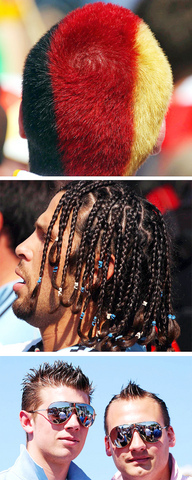
That so much attention is paid to players' hair and to the customary post-game swapping of jerseys no doubt contributes to soccer's standing in the US as a vanity sport, even though it is the most popular sport in other parts of the world. But with the global exposure of the World Cup, players who are famous in their home countries are now influencing style around the world, setting trends, endorsing designer brands and appearing in advertising campaigns.
"There's a euphoria about soccer players like I've never seen here before," said Timothy Everest, the London tailor who outfitted Beckham for his wedding. "When they were doing the walkabout here before the World Cup, it was reminiscent of the Beatles."
Soccer players are passionately studied on and off the field by billions of fans, and designers and athletic clothing brands have responded by courting the most stylish ones. Beckham has been both celebrated and reviled as soccer's most famous clotheshorse, capable of igniting debates on diamond earrings and multistrand beaded necklaces for men, but he is not alone.
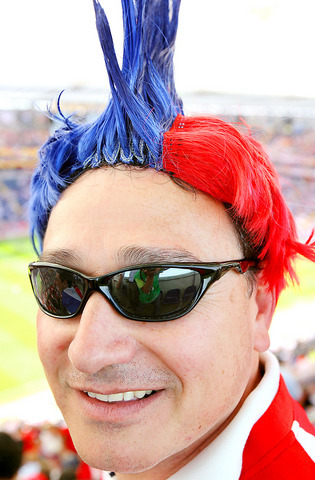
There were fashionista footballers before him -- George Best and Charlie George in England and Charlie Miller in Scotland, to name a few. And many more have since turned up in the front rows of fashion shows and posed seductively for men's wear designers, pushing Beckham, the once unrivaled star of metrosexuality, to fashion's equivalent of the bench.
"I really like Hide Nakata," said Italo Zucchelli, the men's wear designer for Calvin Klein. Zucchelli is Italian and therefore is familiar with the international stars of soccer, among them Hidetoshi Nakata, a 29-year-old midfielder playing for Japan.
Nakata was a star player in the Asian leagues before he was recruited to an Italian team in 1998, and his style and interest in fashion often draw comparisons to Beckham. After Nakata began turning up at the runway shows of Giorgio Armani in Milan and Dior in Paris, often wearing racy T-shirts under a blazer or a fur-trimmed bomber jacket, he became known as the "Asian Becks."
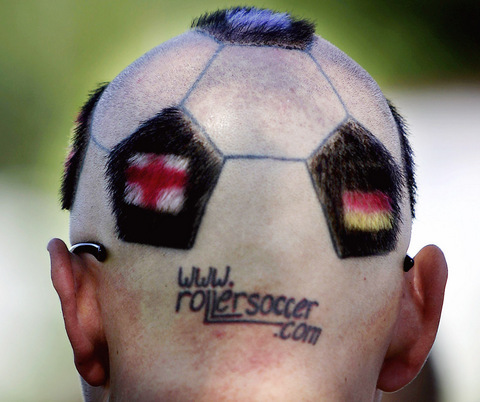
"Beyond the fact he is a really beautiful man, he has a very nice style," Zucchelli said. "He plays with fashion like all of them now, but in a cooler, more sophisticated way than many others."
Other designers and fashion houses -- John Galliano, Prada, Dolce & Gabbana and H&M -- have cited soccer as inspiration for their collections, some claiming that soccer players have more style than other athletes. When Armani announced this month that he would outfit the English team for their appearances off the field at the World Cup, he said, "Footballers are today's new style leaders." This is a bold endorsement from a designer who has usually expended his marketing energy on dressing blue-chip movie stars.
Armani cast the Brazilian midfielder Kaka in his new ads for Emporio Armani, and Andriy Shevchenko, a forward from Ukraine, in an ad for Armani Collezioni. Shevchenko, 29, has an interest in promoting Armani's designs, as he also operates the Armani Collezioni and Armani Jeans franchises in Kiev. Dolce & Gabbana, which designs uniforms for the Milan team's regular season, has cast five of its members in a provocative new underwear campaign, posing in a locker room.
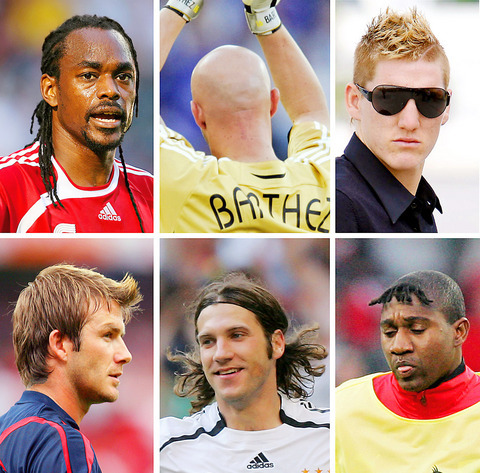
PHOTO: AFP
Greg Williams, a partner at the media consulting company art/words/pictures and a former editor of Arena magazine, wrote about the relationship between soccer players and fashion for the catalog of an exhibition on sports and culture that is opened Wednesday in Florence called Human Game: Winners and Losers. Williams compared the athletes'
celebrity to that of actors and musicians: "Fifteen years ago you'd hire a young white rapper with a six-pack named Marky Mark. Today you hire a Swedish soccer player with a panther tattooed on his abdomen."
Zucchelli noted that Calvin Klein hired that model, Freddie Ljungberg, for its underwear campaign because soccer players were becoming more like media stars, especially in Europe where the company is expanding. The ads not only enhanced Ljungberg's celebrity, they digitally altered his physique. (No, not that. Ljungberg's panther tattoo is actually on his back.)
"Playing with fashion allows you to create a character out of yourself," Zucchelli said. "People respond to that."
The current interest in soccer players echoes the intense branding that has become pervasive in sporting events with a high international profile. Zinedine Zidane of the French team is the face of Dior's Eau Savage, and Lukas Podolski of Germany sells Axe body spray.
Certainly the athletes are aware that a commercially appealing package can reap financial benefits. "What we have seen, especially in Europe, is this sort of fashion-conscious persona many of them have created," Zucchelli said. "There is this very hairstyled player with super-contrived, huge sunglasses and a lot of jewelry. Sometimes it works; sometimes it doesn't."
If the players were not so talented, the level of style competitiveness would threaten to eclipse the sport. Ronaldinho, the Brazilian held up as the world's most talented player, wears his hair long and wavy, pulled back to reveal gaudy earrings with his number in diamonds, and adorably pulls his cuffs down over his hands during warm-ups.
Djibril Cisse, a 24-year-old striker from France, is among the most visually imposing players, often appearing with platinum-dyed facial hair. He is also wont to remove his shirt during play (and shorts in the case of a pinup calendar) to reveal a set of angel's wings tattooed onto his back. Cisse was sidelined from the World Cup last week when he broke his leg.
There are American athletes who are known for their flamboyant style -- Dennis Rodman, the Williams sisters or Johnny Weir -- but in this country there is a puritanical tendency to play down individuality. Think of the constant nattering about hem lengths in basketball and resistance to facial hair in baseball, which is even codified by the New York Yankees' stubble ban, known informally as the Mattingly rule.
Soccer players embrace their eccentricities, a tendency that McLaren of Bumble & Bumble suggests is explained by the pride of those with humble roots who have achieved international success.
"Usually it is the normal kids who become talented," he said. "It's not like a tennis star whose parents spend millions training them to become a star. It's the more common person who has contact with the streets at a young age. They are exposed more to street-level culture. They tend to pick up on that a bit more."
It's a theory, but it does not take into account the styles born of other sports. Just Tuesday, a television report noted a rise in sales of capri pants in Spain, linking the phenomenon to the tennis victory of Rafael Nadal. He wore them at the French Open on Sunday.

The canonical shot of an East Asian city is a night skyline studded with towering apartment and office buildings, bright with neon and plastic signage, a landscape of energy and modernity. Another classic image is the same city seen from above, in which identical apartment towers march across the city, spilling out over nearby geography, like stylized soldiers colonizing new territory in a board game. Densely populated dynamic conurbations of money, technological innovation and convenience, it is hard to see the cities of East Asia as what they truly are: necropolises. Why is this? The East Asian development model, with

June 16 to June 22 The following flyer appeared on the streets of Hsinchu on June 12, 1895: “Taipei has already fallen to the Japanese barbarians, who have brought great misery to our land and people. We heard that the Japanese occupiers will tax our gardens, our houses, our bodies, and even our chickens, dogs, cows and pigs. They wear their hair wild, carve their teeth, tattoo their foreheads, wear strange clothes and speak a strange language. How can we be ruled by such people?” Posted by civilian militia leader Wu Tang-hsing (吳湯興), it was a call to arms to retake

This is a deeply unsettling period in Taiwan. Uncertainties are everywhere while everyone waits for a small army of other shoes to drop on nearly every front. During challenging times, interesting political changes can happen, yet all three major political parties are beset with scandals, strife and self-inflicted wounds. As the ruling party, the Democratic Progressive Party (DPP) is held accountable for not only the challenges to the party, but also the nation. Taiwan is geopolitically and economically under threat. Domestically, the administration is under siege by the opposition-controlled legislature and growing discontent with what opponents characterize as arrogant, autocratic

When Lisa, 20, laces into her ultra-high heels for her shift at a strip club in Ukraine’s Kharkiv, she knows that aside from dancing, she will have to comfort traumatized soldiers. Since Russia’s 2022 invasion, exhausted troops are the main clientele of the Flash Dancers club in the center of the northeastern city, just 20 kilometers from Russian forces. For some customers, it provides an “escape” from the war, said Valerya Zavatska — a 25-year-old law graduate who runs the club with her mother, an ex-dancer. But many are not there just for the show. They “want to talk about what hurts,” she